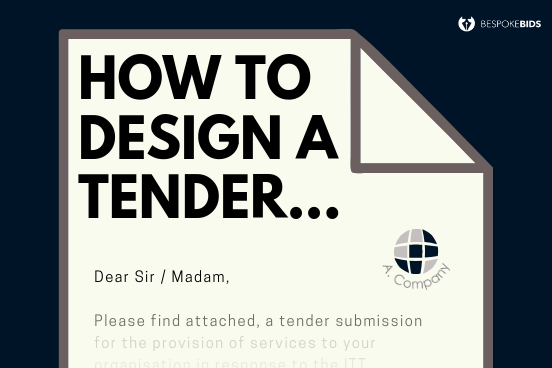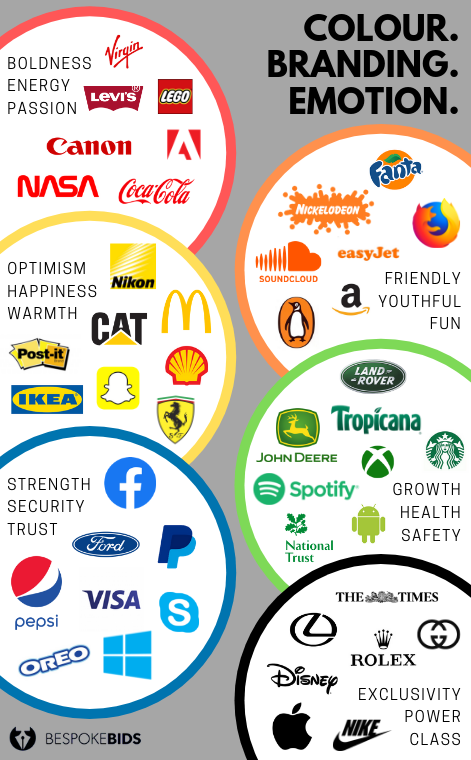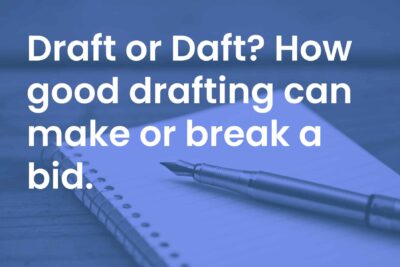
In the public sector, you will rarely be required to present your tender in your own bespoke template. Indeed, even in private tenders, this is rarely a requirement. However, knowing how to properly structure and design a page is invaluable. Whether your design freedoms are limited or completely open, the way your proposal is presented can make a huge difference to your chance of success.
Benefits of good page design:
- Makes a good first impression on your reader.
- Conveys key points more clearly.
- Portrays professionalism and competence.
- Subconsciously influence the buyer’s perception even before they start reading.
Structure
Whether you have a pre-defined template, or must make one from scratch, structuring your responses properly can make a very big difference to your chances. Very subtle methods can be applied to document structuring that can drastically affect readability and overall quality.
Give Your Text Space
A single solid block of text is enough to put anyone off their reading. Instead, use margins, bullet points, columns and headings to break your page structure up and make your arguments easier to follow.
The most important thing here is consistency. If your structure and design is not consistent, you’ll be doing more harm than good.
As long as you remain within the confines of the rules of the tender, use these elements to bring character to your bid and improve readability.
When giving your text room to breath, other things to consider include:
- Headers and Footers
- Typeface (Font / Family / Size)
- Headings / Sub-Headings
- Colour Scheme
- Imagery and Graphics
- Paragraph Settings (Indentation and Spacing etc.)
Structuring Top-Tip
Where permitted, split your page into two columns to give your text more room to breath. Depending on your margin sizes, you may also be able to fit more words on one page.

Design
When considering the design of a proposal, you need to think about a consistent design language across:
- Front and Back Cover
- Title Pages
- Body Pages
- Section Dividers
- Headers and Footers
- Typeface (Font)
- Charts / Graphs / Tables
- Case Studies
- CVs
- Policy Documents
6 Key Design Strategies
Consider these 6 key design strategies in every aspect of the design, structuring and layout of your bid.

1. Contrast – Emphasises, highlights or hides different visual items. Use: Bold Fonts / Colours / Big and Small Elements / Black and White.
2. Proximity – Creates a bond between separate elements. Shows relationships between items.
3. White Space – Gives the page ‘breathing room’. Gives readers a break. Must be balanced and consistent.
4. Consistency – Helps with flow, ease of navigation and generates trust.
5. Balance – Make elements of equal importance, equally prevalent.
6. Alignment – Defines relationships between elements and can influence perception of the overall document.
Colour Theory
Different colours evoke different emotional and psychological responses. It is important to carefully consider the colours you use in your bid as they can easily alter your reader’s perception of you.
Brands around the world carefully use colours to portray specific emotional responses in their target audiences. You should do the same in your bids. Consider this image:

Carefully consider your colour schemes and align them to the tone and scope of your bid and your business:
- A Security company may use RED
- A Cleaning company may use BLUE
- A Care company may use PURPLE
- A Grounds Maintenance company may use GREEN
 Consider, if you don’t already have a defined company colour palette, which you think would be most suitable. If you do already have a defined company colour palette, does it match these guidelines? If not, should it? This is only a guide after all.
Consider, if you don’t already have a defined company colour palette, which you think would be most suitable. If you do already have a defined company colour palette, does it match these guidelines? If not, should it? This is only a guide after all.
Conclusion
Design can mean different things to different people. You may be asking why this is at all relevant to bids. The fact of the matter is that for perhaps 90% of those you write, it isn’t.
Complicated colour theories and design techniques will rarely be relevant, but on those occasions that they are, it’s important to know what you’re doing, or at the very least have considered it.
This article is not intended to be the last word in document design, structuring and layouts, but it is intended to make you aware of just how important these can be.
Did you enjoy this post?
Click here to learn more about how to stop talking about yourself in your bids.
Follow Bespoke Bids on Linkedin to keep up with our day-to-day operations. We post live tenders, tips and tricks and more.


